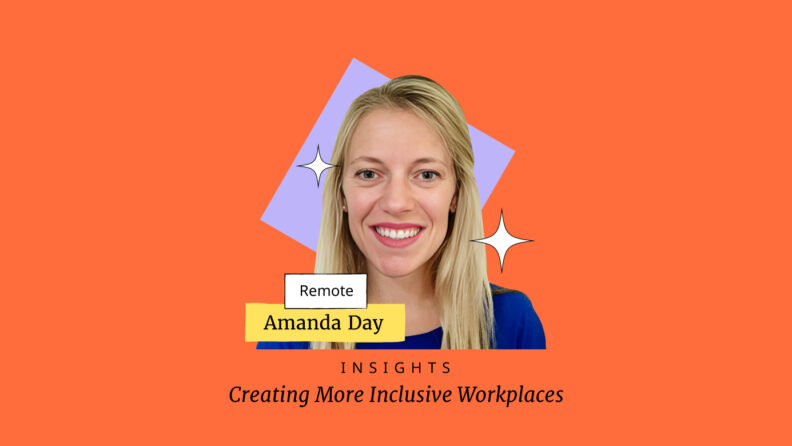Creating inclusive workplaces is crucial for any organization that wants to get the most out of its talent. This means creating an environment where everyone feels like they belong, has equal opportunities, is empowered to do their best work, and feels comfortable making requests and contributing ideas. In this series, we asked prominent HR and business leaders about the steps they take to create more inclusive workplaces.
Hi Amanda, welcome to the series. What systems do you have to ensure your workplace is as inclusive as possible?
- Remote and async working
- Inclusive recruiting
- DEIB training
- Transparency in our performance management and total rewards systems
- Inclusive policies such as parental leave
- Employee resource groups
- Anonymous survey and feedback opportunities
We obviously do remote work at Remote, but we recognize the need to do it intentionally to ensure everyone feels included, heard, and supported.
That means doing a lot of async work, meaning work that doesn’t require people to be online at the same time. We try to use the time when we are all online together for bonding and other things that can’t really be done async.
Inclusivity at Remote really starts in the recruiting phase and continues from there. You have to take an inclusive approach to hiring if you want to have an inclusive company, so we are deliberate in the way we source diverse groups of candidates for open roles and the way we create our job descriptions.”
Remote is unusual in how much transparency we provide. Our entire company handbook for employees is available publicly online at remote.com/handbook, so anyone can see how we operate. That even includes how we calculate compensation and total rewards, as well as how performance ties into that.
Finally, I would also say that benefits are at the heart of inclusivity at Remote. Making a benefits plan that is inclusive of people in more than 70 countries on six continents is a massive challenge but, because we have so much expertise on global benefits within our organization, we are well suited to the task.
For example, we have a generous and robust parental leave policy that covers parents of all genders, as well as adoptive parents, to ensure everyone is covered for that special life event.
Based on your experience and success, what are your top five tips for creating more inclusive workplaces?
- Diverse workforce
- Foster psychological safety
- DEIB training
- Flexible policies (ex: remote and flexible schedule work)
- Listen to your employees
Inclusivity and diversity are not the same thing, but you can’t truly be inclusive if you’re not diverse. Psychological safety is also key—it’s not just enough to have a diverse workplace.
People within that workplace need to feel comfortable raising concerns and speaking honestly with leadership. Otherwise, their problems go unheard and the people and company suffer for it.
DEIB training is a necessity as well. When you have people from cultures all over the world, it’s important for people to know how to listen to and respect one another. One of our core values is kindness, and by hiring with kindness in mind, we get a great head start on finding people who are predisposed to be respectful to one another.
Flexibility is essential too. Flexible hours, flexible locations, and just flexibility in general are very helpful to stay inclusive of people with different demands outside of work. Some people are parents, some people take care of older relatives, and some people have to travel a lot. Flexibility ensures everyone can meet their obligations outside of work while maintaining their ability to perform in their roles.
There's also a correlation between flexible working and mental health outcomes.
Finally, just listen! We run regular engagement surveys and place a great deal of emphasis on the results of those surveys. Managers and senior leaders are responsible for ensuring their teams respond to feedback, and opportunities for feedback are plentiful.
Can you share 3 or 4 of the most common mistakes you have seen businesses make while trying to become more inclusive? What should one keep in mind to avoid that?
- Looking at diversity on a superficial level, inclusivity and belonging are so incredibly important and require intentional work. Only focusing on the diversity of your employees and expecting inclusion to automatically happen could be a mistake.
- Not listening to employees: inclusion is driven at all levels and your employees’ feedback is so important. Consider different avenues you can give your employees to provide feedback in a safe environment and encourage transparent communications.
- Relying on DEIB training as your only DEIB initiative or resource. Inclusion should be an ongoing priority that is given attention.
How do you measure the effectiveness of your DEI efforts?
- Define clear objectives
- Employee surveys like engagement surveys and pulse surveys
- Diversity metrics
- Consider the correlation between DEI metrics and the business performance
It’s all about effective communication and creating safe channels for everyone to share their feedback and experiences so we can track our progress against the goals we set. We run regular engagement surveys and place a great deal of emphasis on the results of those surveys, so team members feel motivated and empowered to share their experiences so we can continually progress forward.
What do you do to address Proximity Bias? How do you ensure remote workers are treated the same as onsite workers and have equal access to opportunities?
Remote is fully remote, so we don’t have any offices. For companies with hybrid models of office and remote workers, it is vital that everyone take a remote-first approach to ensure everyone has an equitable experience.
That means keeping conversations about work in public channels where remote workers can participate, as well as having recorded meetings on Zoom instead of in closed-off conference rooms where remote workers can’t go.
Thanks Amanda, how can our readers further follow your work?
Check out our Remote blog and follow me on LinkedIn! We have some great content to help global team leaders improve their remote work leadership and some really practical resources for implementing DEIB, and I have written several of these pieces myself. It’s a real passion point as you can tell.


